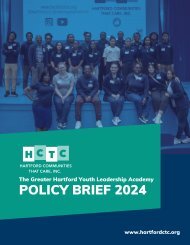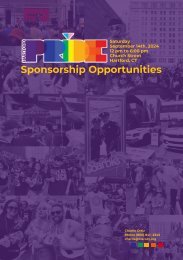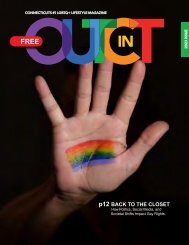OUTINCT 2022
Create successful ePaper yourself
Turn your PDF publications into a flip-book with our unique Google optimized e-Paper software.
Without supportive, affirming environments, LGBTQIA+
youth face school environments that not only hinder their
success, but are unsafe. According to research, LGBTQIA+
youth have higher chances of experiencing stress and
fear in school compared to their non-LGBTQIA+ peers;
they are more likely to endure verbal harassment and
physical harassment and assault because of their sexuality
and gender expression. Because of these experiences,
LGBTQIA+ youth are less likely to attend school and to
graduate (https://youth.gov/youth-topics/lgbtq-youth/
school-experiences ). The Trevor
Project’s National Survey on LGBTQ
Youth Mental Health 2021 reports that
36% of LGBTQ surveyed youth have
been physically threatened or harmed
due to either their sexual orientation
or gender identity and that 60% of
LGBTQIA+ youth who wanted mental
health care in the past year were not
able to get it. Suicide rates among the
LGBTQIA+ youth surveyed are also
staggering, especially when looking
across racial groups; the survey
revealed that 31% of Native/Indigenous
youth, 21% of Black youth, 21% of
multiracial youth, and 18% of Latinx
youth attempted suicide compared
to 12% of Asian/Pacific Islander youth
and 12% of white youth. The same
survey one year later revealed these
stark disparities had not changed much
at all (https://www.thetrevorproject.
org/survey-2022/assets/static/
trevor01_2022survey_final.pdf ). The
Trevor Project finds that access to
spaces that affirm sexual orientation
and gender identity result in lower rates of suicide among
LGBTQIA+ youth as well as, according to GLSEN’s most
recent National School Climate Survey, lower rates of
missed school, increased academic performance, and
increased chances of continued education beyond high
school. What these data suggest then is that schools
have a tremendous opportunity to be spaces where
LGBTQIA+ students can fully thrive as their full and
whole selves. Furthermore, this work is imperative to
intentionally fostering safety and authentic care. We must
also remember that safety alone should be a baseline for
all students. What about opportunities to experience joy
and spaces where they see themselves reflected in school?
Schools and those who lead them must be thinking
about how the ways we teach, engage, and relate through
the lens of gender and sexuality inclusivity must be at
the forefront of our commitments to equity and racial
justice. Children are whole people and it is impossible
to disentangle the ways that homophobia, transphobia,
Schools have a tremendous
opportunity to be spaces
where LGBTQIA+ students
can fully thrive as their full
and whole selves.
ableism, classism, xenophobia, and Islamophobia conspire
to fuel systemic racism. Educators who interrogate and
know deeply what it means to be a queer Black student
with disabilities in their high school have spent the time
to critically consider the ways their equity lens is serving
(or not serving) the most historically excluded youth. “An
equity lens is one through which decisions and actions are
made: 1) centering the value of equity, 2) mitigating the
influence of bias, & 3) elevating the experiences, needs,
and voices of folx from historically excluded identities’’
(McCabe Zwerger, 2022). Educators
who have proactively considered
how to respond to the first seventh
grader with acne who is harassed by
peers calling them gay and telling
them they have monkey pox are
educators interested in addressing the
root, not just the fruit of that violence.
Histories and legacies of homophobia
and transphobia are present in our
everyday interactions today in 2022
and ensuring we don’t repeat and
relive what has happened in the past
demands a more human-centered
approach that is anchored in equity
and justice.
There is more to this work than
sharing pronouns and offering onetime
trainings on bias. There are
structural, relational, and communitycentered
practices required to
center LGBTQIA+ student voices,
lived experiences, and needs. From
ensuring safe access to all gender
restrooms to ensuring all educators,
including substitutes, are calling students their names
(not just what is on the roster), to purposefully ensuring
staff can navigate family dynamics for students whose
identities do not align with the story told about them on
paper, this commitment requires work. School Boards
must adopt policies for the protection of trans, gender
non-conforming, and non-binary youth, staff, family, and
community members and these policies must come alive
in our curriculum and pedagogy.
Curriculum is a power tool when we are seeking to
advance values for equity and social justice. If we aren’t
talking about gender and sexuality, then we aren’t centering
or including them. LGBTQIA+ students face erasure,
stereotyping, stigma, bullying, and violence in school
settings that aren’t openly engaged in dialogue. GLSEN’s
most recent National School Climate Survey found that
less than one out of five LGBTQIA+ students attend schools
with an LGBTQ-inclusive curriculum (https://www.glsen.
org/research/2019-national-school-climate-survey ).
7 | LGBTQ+ GUIDE OF CT







